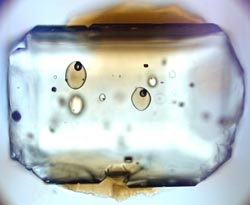Deep recycling in the Earth faster than thought

Olivine crystals from Mauna Loa volcano, Hawaii. The brown ovals are solidified, glassy inclusions trapped as droplets of melt by the growing olivine crystal. They contain strontium isotope ratios which are inherited from 500 million year old seawater. The black dots are gas inclusions.<br>Image: Sobolev, Max Planck Institute for Chemistry.<br>
The recycling of the Earth´s crust in volcanoes happens much faster than scientists have previously assumed. Rock of the ocean crust, which sinks deep into the earth due to the movement of tectonic plates, reemerges through volcanic eruptions after around 500 million years. Researchers from the Max Planck Institute for Chemistry in Mainz obtained this result using volcanic rock samples. Previously, geologists thought this process would take about two billion years.
Virtually all of the ocean islands are volcanoes. Several of them, such as Hawaii, originate from the lowest part of the mantle. This geological process is similar to the movement of colored liquids in a lava lamp: hot rock rises in cylindrical columns, the so-called mantle plumes, from a depth of nearly 3000 kilometers. Near the surface, it melts, because the pressure is reduced, and forms volcanoes. The plume originates from former ocean crust which early in the Earth´s history sank to the bottom of the mantle. Previously, scientists had assumed that this recycling took about two billion years.
The chemical analysis of tiny glassy inclusions in olivine crystals from basaltic lava on Mauna Loa volcano in Hawaii has now surprised geologists: the entire recycling process requires at most half a billion years, four times faster than previously thought.
The microscopically small inclusions in the volcanic rock contain trace elements originally dissolved in seawater, and this allows the recycling process to be dated. Before the old ocean crust sinks into the mantle, it soaks up seawater, which leaves tell-tale trace elements in the rock. The age is revealed by the isotopic ratio of strontium which changes with time. Strontium is a chemical element, which occurs in trace amounts in sea water. The isotopes of chemical elements have the same number of protons but different numbers of neutrons. Mainz scientists developed a special laser mass spectrometry method which allowed the detection of isotopes of strontium in extremely small quantities.
To their surprise, the Max Planck researchers found residues of sea water with an unexpected strontium isotope ratio in the samples, which suggested an age of less than 500 million years for the inclusions. Therefore the rock material forming the Hawaiian basalts must be younger as previously thought.
“Apparently strontium from sea water has reached deep in the Earth´s mantle, and reemerged after only half a billion years, in Hawaiian volcano lavas,” says Klaus Jochum, co-author of the publication. “This discovery was a huge surprise for us.”
Another surprise for the scientists was the tremendous variation of strontium isotope ratios found in the melt inclusions in olivine from the single lava sample. “This variation is much larger than the known range for all Hawaiian lavas”, says Alexander Sobolev. “This finding suggests that the mantle is far more chemically heterogeneous on a small spatial scale than we thought before.” This heterogeneity is preserved only by melt inclusions but is completely obliterated in the lavas because of their complete mixing.
Sobolev, Jochum and their colleagues expect to obtain similar results for other volcanoes and therefore be able to determine the recycling age of the ocean crust more precisely.
The Max Planck Institute for Chemistry
Around 260 people work at the Max Planck Institute for Chemistry, researching the earth and its environment at various levels from nanoparticles to planets and from ecosystem dynamics to global climate change. There are three departments studying the earth system in field studies, under lab conditions and with the aid of computer-assisted modeling. The institute is helping develop our understanding of the earth's natural resources and providing the solutions for sustainable use of our planet and environmental protection. The institute's International Research School and E-learning program are an active contribution to scientific education. The Max Planck Institute for Chemistry is actively involved in the event program of the City of Science in Mainz in 2011. Next year the Institute celebrates its´ 100th anniversary.
More Information: http://www.mpic.de
Publication:
Alexander V. Sobolev, Albrecht W. Hofmann, Klaus Peter Jochum, Dmitry V. Kuzmin & Brigitte Stoll
A young source for the Hawaiian plume
Nature, 10 August, 2011
Contact:
Prof. Dr. Alexander Sobolev
Max Planck Institute for Chemistry, Mainz
Phone: +49 6131-305 609
E-mail: alexander.sobolev@mpic.de
Dr. Klaus Jochum
Max Planck Institute for Chemistry, Mainz
Phone: +49 6131-305 216
E-mail: k.jochum@mpic.de
Media Contact
More Information:
http://www.mpic.deAll latest news from the category: Earth Sciences
Earth Sciences (also referred to as Geosciences), which deals with basic issues surrounding our planet, plays a vital role in the area of energy and raw materials supply.
Earth Sciences comprises subjects such as geology, geography, geological informatics, paleontology, mineralogy, petrography, crystallography, geophysics, geodesy, glaciology, cartography, photogrammetry, meteorology and seismology, early-warning systems, earthquake research and polar research.
Newest articles

“Nanostitches” enable lighter and tougher composite materials
In research that may lead to next-generation airplanes and spacecraft, MIT engineers used carbon nanotubes to prevent cracking in multilayered composites. To save on fuel and reduce aircraft emissions, engineers…

Trash to treasure
Researchers turn metal waste into catalyst for hydrogen. Scientists have found a way to transform metal waste into a highly efficient catalyst to make hydrogen from water, a discovery that…

Real-time detection of infectious disease viruses
… by searching for molecular fingerprinting. A research team consisting of Professor Kyoung-Duck Park and Taeyoung Moon and Huitae Joo, PhD candidates, from the Department of Physics at Pohang University…




















